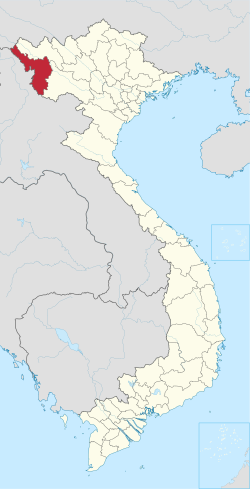Điện Biên
|
Điện Biên Province Tỉnh Điện Biên |
|
|---|---|
| Province | |

Mường Ảng district
|
|
| Nickname(s): Stable frontier | |
 Location of Điên Biên within Vietnam |
|
| Coordinates: 21°23′N 103°1′E / 21.383°N 103.017°ECoordinates: 21°23′N 103°1′E / 21.383°N 103.017°E | |
| Country |
|
| Region | Northwest |
| Capital | Điên Biên Phủ |
| Area | |
| • Total | 9,560 km2 (3,690 sq mi) |
| Population (2004) | |
| • Total | 440,800 |
| • Density | 46/km2 (120/sq mi) |
| Demographics | |
| • Ethnicities | Vietnamese/Kinh, H'Mông, Dao, Thai |
| Time zone | ICT (UTC+7) |
| Area codes | 215 |
| ISO 3166 code | VN-71 |
| Website | www |
Điện Biên (![]() listen) is a province in the Northwest region of Vietnam. It is bordered by Lai Châu to the north east, Sơn La provinces of Vietnam to the south east, Pu'er City, Yunnan, China, to the northwest, and Phongsaly Province in Laos to the west.
listen) is a province in the Northwest region of Vietnam. It is bordered by Lai Châu to the north east, Sơn La provinces of Vietnam to the south east, Pu'er City, Yunnan, China, to the northwest, and Phongsaly Province in Laos to the west.
The province's name derives from the Sino-Vietnamese "", meaning "stable frontier" (referring to Điện Biên's location on the border between Lan Xang and Đại Việt). Điện Biên has various ancient monuments including the caves Thẩm Khương, as well as Thẩn Búa in Tuần Giáo. The original settlers were the ai Lao or Tai people which is a direct ancestor of Lao people in Laos today. name of villages or towns are still using Lao word eg: Mường(city), Tham(cave)
In the 9th and 10th centuries, the Lự ở Mường Thanh people were the most developed in the area and controlled Sìn Hồ, Mường Lay, and Tuần Giáo.
In the 11th and 12th centuries, Tai (not Thai of Thailand) people from Mường Ôm and Mường Ai occupied Mường Lò in Nghĩa Lộ and Mường Thenh in Điện Biên. They eventually gained control of the whole area between Mường Lò, Mường Lò and Mường Thanh (Điện Biên).
Điện Biên is subdivided into 10 district-level sub-divisions:
They are further subdivided into five commune-level towns (or townlets), 116 communes, and nine wards.
...
Wikipedia
